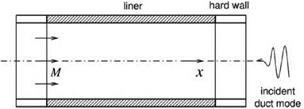Acoustic Wave Propagation and Scattering in a Duct with Acoustic Liner Splices
Inside the inlet or the exhaust duct of a jet engine, the continuous reflections of acoustic waves by the walls lead to the formation of coherent propagating wave entities called duct modes or acoustic modes. These duct modes were first found by Tyler and Sofrin (1962) and have been the subject of numerous studies since. To suppress the duct modes, acoustic liners are commonly used. Because of installation and maintenance issues, a single large piece of liner is seldom used. A practical way is to install several smaller pieces of liners separated by hard wall splices. The presence of hard wall splices causes the scattering of the duct modes generated by the rotating fan blades of the engine. The scattered duct modes would, inevitably, include lower-order spinning azimuthal modes. The lower-order modes are not as heavily damped by the acoustic liner. This results in a higher level of radiated noise from the engine. This is extremely undesirable.
In this section, three numerical examples are presented to illustrate the effectiveness and accuracy of the time-domain impedance boundary condition and the wave number truncation method (see Section 9.6) for computing acoustic wave propagation and scattering in ducts with material discontinuities. These examples have practical relevance to jet engine duct acoustics. The inlet duct of a jet engine generally has a nearly circular geometry. The inside surface is covered by an acoustic liner. The liner occupies the space between two hard wall surfaces. One hard wall surface is the metallic surface surrounding the fan of the engine. The other hard wall surface is the lip of the engine inlet. Acoustic or duct modes are generated by the rotating fan of the engine. The duct modes propagate from the fan face upstream against the flow. They are radiated out from the inlet. A simplified model of the inlet duct is shown in Figure 10.12. This model has been used by numerous investigators for computing duct/acoustic mode propagation in jet engine ducts; e. g., Regan and Eaton (1999), McAlpine et al. (2003), Tester et al. (2006), and Tam et al. (2008). For a number of practical reasons, it is a standard practice to install hard wall splices
Figure 10.12. A computational model of the inlet duct of a jet engine.
 to separate a liner into smaller pieces. Two types of splices are used. The more common type is the axial splice. An axial splice runs along the entire length of the liner. Figure 10.13 shows an inlet duct with two axial splices. Instead of axial splices, circumferential splices are often used. These splices form a ring around the inside surface of the duct. A duct with a circumferential splice is shown in Figure 10.14.
to separate a liner into smaller pieces. Two types of splices are used. The more common type is the axial splice. An axial splice runs along the entire length of the liner. Figure 10.13 shows an inlet duct with two axial splices. Instead of axial splices, circumferential splices are often used. These splices form a ring around the inside surface of the duct. A duct with a circumferential splice is shown in Figure 10.14.
In the following examples, dimensionless variables are used. The scales of the various variables are: length scale D (diameter of the duct), velocity scale a0 (speed of sound), time scale D/a0, density scale p0 (mean flow density), pressure scale p0a2, and impedance scale p0a0.











